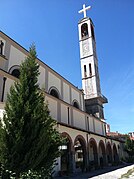Religion in Albania
Religion in Albania as of the 2023 census conducted by the Institute of Statistics (INSTAT)[1]
Albania is a secular and religiously diverse country with no official religion and thus, freedom of religion, belief and conscience are guaranteed under the country's constitution.[2] Islam is the most common religion in Albania, followed by Christianity, though religiosity is low and there are many irreligious Albanians. In the 2023 census, Muslims (Sunni, Bektashians and non-denominationals) accounted for 51% of the total population, Christians (Catholics, Orthodox and Evangelicals) made up 16%, while irreligious (Atheists and the other non-religious) were 17%. The other 16% were undeclared.[1][3][4][5]
Albania has been a secular state since 1912 and thus and currently according to the constitution, the state has to be "neutral in questions of belief and conscience":[6] The former socialist government started the anti-religious campaign in 1967 and was declared Albania the world's first constitutionally "atheist state" in 1976. Believers faced harsh punishments, and many clergymen were killed. Nowadays religious observance and practice is generally lax, and polls have shown that, compared to the populations of other countries, few Albanians consider religion to be a dominant factor in their lives. When asked about religion, people generally refer to their family's historical religious legacy and not to their own choice of faith.[7][8][9][10]
History
Antiquity
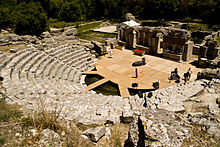
Christianity spread to urban centers in the region of Albania, at the time composed mostly Epirus Nova and part of south Illyricum, during the later period of Roman era and reached the region relatively early. St. Paul preached the Gospel 'even unto Illyricum' (Romans 15:19). Schnabel asserts that Paul probably preached in Shkodra and Durrës.[11] The steady growth of the Christian community in Dyrrhachium (the Roman name for Epidamnus) led to the creation of a local bishopric in 58 AD. Later, episcopal seats were established in Apollonia, Buthrotum (modern Butrint), and Scodra (modern Shkodra).
One notable Martyr was Saint Astius, who was Bishop of Dyrrachium, who was crucified during the persecution of Christians by the Roman Emperor Trajan. Saint Eleutherius (not to be confused with the later Saint-Pope) was bishop of Messina and Illyria. He was martyred along with his mother Anthia during the anti-Christian campaign of Hadrian.[12]
From the 2nd to the 4th centuries, the main language used to spread the Christian religion was Latin,[13] whereas in the 4th to the 5th centuries it was Greek in Epirus and Macedonia and Latin in Praevalitana and Dardania. Christianity spread to the region during the 4th century, however the Bible cites in Romans that Christianity was spread in the first century. The following centuries saw the erection of characteristic examples of Byzantine architecture such as the churches in Kosine, Mborje and Apollonia.
Christian bishops from what would later become eastern Albania took part in the First Council of Nicaea. Arianism had at that point extended to Illyria, where Arius himself had been exiled to by Constantine.[14]
Middle Ages

Since the early 4th century AD, Christianity had become the established religion in the Roman Empire, supplanting pagan polytheism and eclipsing for the most part the humanistic world outlook and institutions inherited from the Greek and Roman civilizations. Ecclesiastical records during the Slavic invasions are slim. Though the country was in the fold of Byzantium, Christians in the region remained under the jurisdiction of the Roman pope until 732. In that year the iconoclast Byzantine emperor Leo III, angered by archbishops of the region because they had supported Rome in the Iconoclastic Controversy, detached the church of the province from the Roman pope and placed it under the patriarch of Constantinople. When the East-West schism separated the Western Christianity from Greek Christianity, southern Albanian regions retained their ties to Constantinople while the northern areas reverted to the jurisdiction of Rome.

The Albanians first appear in the historical record in Byzantine sources of the 11th century. At this point, they are already fully Christianized. Most Albanian regions belonged to the Eastern Orthodox Church after the schism, but regional Albanian populations gradually became Catholic to secure their independence from various Orthodox political entities[15][16][17] and conversions to Catholicism would be especially notable under the aegis of the Kingdom of Albania.[citation needed] Flirtations with conversions to Catholicism in Central Albanian Principality of Arbanon are reported in the later 12th century,[18] but until 1204 Central and Southern Albanians (in Epirus Nova) remained mostly Orthodox despite the growing Catholic influence in the North and were often linked to Byzantine[19] and Bulgarian state entities[20] Krujë, however, became an important center for the spread of Catholicism. Its bishopric had been Catholic since 1167. It was under direct dependence from the pope and it was the pope himself who consecrated the bishop.[21] Local Albanian nobles maintained good relations with the Papacy. Its influence became so great, that it began to nominate local bishops. The Archbishopric of Durrës, one of the primary bishoprics in Albania had initially remained under the authority of Eastern Orthodox Church after the split despite continuous, but fruitless efforts from Rome to convert it to the Latin Church.[citation needed]
After the Fourth Crusade

However, things changed after the fall of Byzantine Empire in 1204. In 1208, a Catholic archdeacon was elected for the archbishopric of Durrës. After the reconquest of Durrës by the Despotate of Epirus in 1214, the Latin Archbishop of Durrës was replaced by an Orthodox archbishop.[22] According to Etleva Lala, on the edge of the Albanian line in the north was Prizren, which was also an Orthodox bishopric albeit with some Catholic parochial churches,[23] in 1372 received a Catholic bishop due to close relations between the Balsha family and the Papacy.[24]
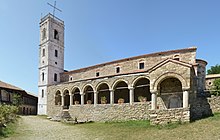
After the Fourth Crusade, a new wave of Catholic dioceses, churches and monasteries were founded, a number of different religious orders began spreading into the country, and papal missionaries traversed its territories. Those who were not Catholic in Central and North Albania converted and a great number of Albanian clerics and monks were present in the Dalmatian Catholic institutions.[25] The creation of the Kingdom of Albania in 1272, with links to and influence from Western Europe, meant that a decidedly Catholic political structure had emerged, facilitating the further spread of Catholicism in the Balkans.[26] Durrës became again a Catholic archbishopric in 1272. Other territories of the Kingdom of Albania became Catholic centers as well. Butrint in the south, although dependent on Corfu, became Catholic and remained as such during the 14th century. The bishopric of Vlore also converted immediately following the founding of the Kingdom of Albania.[27] Around 30 Catholic churches and monasteries were built during the rule of Helen of Anjou, as Queen consort of the Serbian Kingdom, in North Albania and in Serbia.[26] New bishoprics were created especially in North Albania, with the help of Helen.[28] As Catholic power in the Balkans expanded with Albania as a stronghold, Catholic structures began appearing as far afield as Skopje (which was a mostly Serbian Orthodoxy city at the time[29]) in 1326, with the election of the local bishop there being presided upon by the Pope himself;[30] in the following year, 1327, Skopje sees a Dominican appointed.[29]

However, in Durrës the Byzantine Rite continued to exist for a while after Angevin conquest. This double-line of authority created some confusion in the local population and a contemporary visitor of the country described Albanians as nor they are entirely Catholic or entirely schismatic. In order to fight this religious ambiguity, in 1304, Dominicans were ordered by Pope Benedict XI to enter the country and to instruct the locals in the Latin liturgical rites. Dominican priests were also ordered as bishops in Vlorë and Butrint.[31]
In 1332 a Dominican priest reported that within the Kingdom of Rascia (Serbia) there were two Catholic peoples, the "Latins" and the "Albanians", who both had their own language. The former was limited to coastal towns while the latter was spread out over the countryside, and while the language of the Albanians was noted as quite different from Latin, both peoples are noted as writing with Latin letters. The author, an anonymous Dominican priest, writing in favor of a Western Catholic military action to expel Orthodox Serbia from areas of Albania it controlled in order to restore the power of the Catholic church there, argued that the Albanians and Latin and their clerics were suffering under the "extremely dire bondage of their odious Slav leaders whom they detest" and would eagerly support an expedition of " one thousand French knights and five or six thousand foot soldiers" who, with, their help, could throw off the rule of Rascia.[32]
Although Serbian rulers at earlier times had at times relations with the Catholic West despite being Orthodox, as a counterbalance to Byzantine power, and therefore tolerated the spread of Catholicism in their lands, under the reign of Stefan Dušan the Catholics were persecuted, as were also Orthodox bishops loyal to Constantinople. The Catholic rite was called Latin heresy and, angered in part by marriages of Serbian Orthodox with "half-believers" and the Catholic proselytization of Serbians, Dušan's Code, the Zakonik contained harsh measures against them.[33] However, the persecutions of local Catholics did not begin in 1349 when the Code was declared in Skopje, but much earlier, at least since the beginning of the 14th century. Under these circumstances the relations between local Catholic Albanians and the papal curia became very close, while the previously friendly relations between local Catholics and Serbians deteriorated significantly.[34]
Between 1350 and 1370, the spread of Catholicism in Albania reached its peak. At that period there were around seventeen Catholic bishoprics in the country, which acted not only as centers for Catholic reform within Albania, but also as centers for missionary activity in the neighboring areas, with the permission of the pope.[25] At the end of the 14th century, the previously Orthodox Autocephalous Archbishopric of Ohrid was dismantled in favor of the Catholic rite.[35]
Renaissance

Christianity was later overshadowed by Islam, which became the predominant religion during the invasion from the Ottoman Empire from the 15th century until the year 1912. Many Albanians embraced Islam in different ways.
Albania differs from other regions in the Balkans in that the peak of Islamization in Albania occurred much later: 16th century Ottoman census data showed that sanjaks where Albanians lived remained overwhelmingly Christian with Muslims making up no more than 5% in most areas (Ohrid 1.9%, Shkodra 4.5%, Elbasan 5.5%, Vlora 1.8%, Dukagjin 0%) while during this period Muslims had already risen to large proportions in Bosnia (Bosnia 46%, Herzegovina 43%, urban Sarajevo 100%), Northern Greece (Trikala 17.5%), North Macedonia (Skopje and Bitola both at 75%) and Eastern Bulgaria (Silistra 72%, Chirmen 88%, Nikopol 22%). Later on, in the 19th century, when the process of Islamization had halted in most of the Balkans and some Balkan Christian peoples like Greeks and Serbs had already claimed independence, Islamization continued to make significant progress in Albania, especially in the South.[36]
As a rule, Ottoman rule largely tolerated Christian subjects but it also discriminated against them, turning them into second-class citizens with much higher taxes and various legal restrictions like being unable to take Muslims to court, have horses, have weapons, or have houses overlooking those of Muslims. While Catholicism was chronically held in suspicion by Ottoman authorities, after the conquest of Constantinople, the Ottomans largely allowed the Orthodox church to function unhindered, except during periods when the church was considered politically suspect and thus suppressed with expulsions of bishops and seizure of property and revenues. Conversion during Ottoman times was variously due to calculated attempts to improve social and economic status, due to the successful proselytizing by missionaries, or done out of desperation in very difficult times; in the latter case, the converts often practised crypto-Christianity for long periods. During the Ottoman period, most Christians as well as most Muslims employed a degree of syncretism, still practising various pagan rites; many of these rites are best preserved among mystical orders like the Bektashi.[37]

Unlike some other areas of the Balkans, such as Bulgaria and Bosnia, for the first couple centuries of Ottoman rule, up until the 1500s, Islam remained confined to members of the co-opted aristocracy and a couple scattered military settlements of Yuruks from Anatolia, while the native Albanian peasantry remained overwhelmingly Christian.[38][39] Even long after the fall of Skanderbeg, large regions of the Albanian countryside frequently rebelled against Ottoman rule, often incurring large human costs, including the decimation of whole villages.[40] In the 1570s, a concerted effort by Ottoman rulers to convert the native population to Islam in order to stop the occurrence of seasonal rebellions began in Elbasan and Reka.[41] In 1594, the Pope incited a failed rebellion among Catholic Albanians in the North, promising help from Spain. However the assistance did not come, and when the rebellion was crushed in 1596, Ottoman repression and heavy pressures to convert to Islam were implemented to punish the rebels.[38]
Between 1500 and 1800, impressive ecclesiastical art flourished across Southern Albania. In Moscopole there were over 23 churches during the city's period of prosperity in the mid 18th century.[42] Post-Byzantine architectural style is prevalent in the region, e.g. in Vithkuq, Labove, Mesopotam, Dropull.[43]
Christianity and Islam in the North under Ottoman Rule
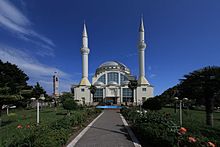
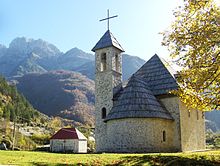

Ramadan Marmullaku noted that, in the 1600s, the Ottomans organized a concerted campaign of Islamization that was not typically applied elsewhere in the Balkans, in order to ensure the loyalty of the rebellious Albanian population.[39][45] Although there were certain instances of violently forced conversion, usually this was achieved through debatably coercive economic incentives – in particular, the head tax on Christians was drastically increased.[46] While the tax levied on Albanian Christians in the 1500s amounted to about 45 akçes, in the mid-1600s, it was 780 akçes.[47] Conversion to Islam here was also aided by the dire state of the Catholic church in the period— in the entirety of Albania, there were only 130 Catholic priests, many of these poorly educated.[48] During this period, many Christian Albanians fled into the mountains to found new villages like Theth, or to other countries where they contributed to the emergence of Arvanites, Arbëreshë, and Arbanasi communities in Greece, Italy, and Croatia. While in the first decade of the 17th century, Central and Northern Albania remained firmly Catholic (according to Vatican reports, Muslims were no more than 10% in Northern Albania[49]), by the middle of the 17th century, 30–50% of Northern Albania had converted to Islam, while by 1634 most of Kosovo had also converted.[50] During this time, the Venetian Republic helped to prevent the wholesale Islamisation of Albania, maintaining a hold on parts of the north near the coast.

This period also saw the emergence of Albanian literature, written by Christians such as Pjetër Bogdani. Some of these Christian Albanian thinkers, like Bogdani himself, ultimately advocated for an Albania outside of Ottoman control, and at the end of the 17th century, Bogdani and his colleague Raspasani, raised an army of thousands of Kosovar Albanians in support of the Austrians in the Great Turkish War. However, when this effort failed to expel Ottoman rule from the area yet again, many of Kosovo's Catholics fled to Hungary.[52]
In 1700, the Papacy passed to Pope Clement XI, who was himself of Albanian-Italian origins and held great interest in the welfare of his Catholic Albanian kinsmen, known for composing the Illyricum sacrum. In 1703 he convened the Albanian Council (Kuvendi i Arbënit) in order to organize methods to prevent further apostacy in Albania, and preserve the existence of Catholicism in the land.[53] The widespread survival of Catholicism in northern Albania is largely attributable to the activity of the Franciscan order in the area[48]
In addition to Catholicism and Sunni Islam, there were pockets of Orthodox (some of whom had converted from Catholicism) in Kavajë, Durrës, Upper Reka and some other regions, while Bektashis became established in Kruja, Luma, Bulqiza, Tetova, and Gjakova. Especially in the tribal regions of the North, religious differences were often mitigated by common cultural and tribal characteristics, as well as knowledge of family lineages connecting Albanian Christians and Albanian Muslims. In the 17th century, although many of the rebellions of the century were at least in part motivated by Christian sentiment, it was noted that many Albanian Muslims also took part, and that, despising Ottoman rule no less than their Christian brethren, Albanian Muslims would revolt eagerly if only given the slightest assistance from the Catholic West.[47]
Christianity and Islam in the South under Ottoman Rule

In the late 17th and 18th centuries, especially after numerous rebellions including during the Great Turkish War and subsequent clashes with Orthodox Russia, Ottoman rulers also made concerted efforts to convert the Orthodox Albanians of Southern and Central Albania (as well as neighboring regions of Greece and Macedonia).[54][55] Like in the North, conversion was achieved through a diverse motley of violent, coercive[56] and non-coercive means, but raised taxes were the main factor. Nevertheless, there were specific local cases: in Vlora and the surrounding region, the Christians converted en masse once the area was recaptured from the Christian forces in 1590, because they feared violent retribution for their collaboration.[55][57] In Labëri, meanwhile, mass conversion took place during a famine in which the bishop of Himara and Delvina was said to have forbidden the people from breaking the fast and consuming milk under threat of interminable hell. Across Orthodox regions of Albania, conversion was also helped by the presence of heresies like Arianism and the fact that much of the Orthodox clergy was illiterate, corrupt, and conducted sermons in Greek, a foreign language, as well as the poverty of the Orthodox church.[55] The clergy, largely from the Bosphorus, was distant from its Albanian flocks and also corrupt as well, abusing church tax collection and exacting a heavy tax regime that aggregated on top of punitive taxes imposed directly by the Ottoman state on the rebellious Albanian Christian population aimed at sparking their conversion.[47]

Orthodox areas further north, such as those around Elbasan, were first to convert, during the 1700s, passing through a stage of Crypto-Christianity[58] although in these regions scattered Orthodox holdouts remained (such as around Berat, in Zavalina, and the quite large region of Myzeqe including Fier and Lushnjë) as well as continuing Crypto-Christianity around the region of Shpati among others, where Crypto-Christians formally reverted to Orthodoxy in 1897.[47] Further south, progress was slower. The region of Gjirokastra did not become majority Muslim until around 1875, and even then most Muslims were concentrated in the city of Gjirokastra itself.[55] The same trajectory was true of Albanians in Chamëria, with the majority of Cham Albanians remaining Orthodox until around 1875— at which point Ottoman rule in the Balkans was already collapsing and many Christian Balkan states had already claimed independence (Greece, Serbia, Romania).[54]
At the end of the Ottoman period, Sunni Islam held a slight majority (or plurality) in the Albanian territories. Catholicism still prevailed in the Northwestern regions surrounding Lezha and Shkodra, as well as a few pockets in Kosovo in and around Gjakova, Peja, Vitina, Prizren and Klina. Orthodoxy remained prevalent in various pockets of Southern and Central Albania (Myzeqeja, Zavalina, Shpati as well as large parts of what are now the counties of Vlora, Gjirokastra and Korca). The syncretic Bektashi sect, meanwhile, gained adherence across large parts of the South, especially Skrapari and Dishnica where it is the overwhelming majority. This four-way division of Albanians between Sunnis (who became either a plurality or a majority), Orthodox, Bektashis and Catholics, with the later emergence of Albanian Uniates, Protestants and atheists, prevented Albanian nationalism as it emerged from tying itself to any particular faith, instead promoting harmony between the different confessions and using the shared Albanian language, Albanian history and Albanian ethnic customs as unifying themes. Despite this, Bektashi tekkes in the South and Catholic churches in the North were both used by the nationalist movement as places of dissemination of nationalist ideals.
Modern
Independence
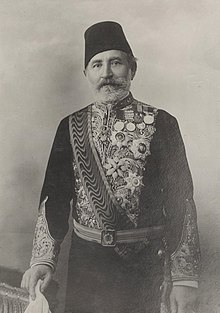

During the 20th century after Independence (1912) the democratic, monarchic and later the totalitarian regimes followed a systematic dereligionization of the nation and the national culture. Albania never had an official state religion either as a republic or as a kingdom after its restoration in 1912.[59] Religious tolerance in Albania was born of national expediency and a general lack of religious convictions.[60]
Monarchy
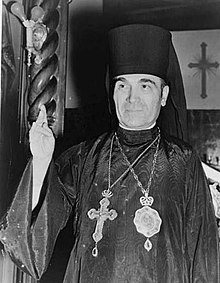
Originally under the monarchy, institutions of all confessions were put under state control. In 1923, following the government program, the Albanian Muslim congress convened at Tirana decided to break with the Caliphate, established a new form of prayer (standing, instead of the traditional salah ritual), banished polygamy and did away with the mandatory use of veil (hijab) by women in public, which had been forced on the urban population by the Ottomans during the occupation.[61]
In 1929 the Albanian Orthodox Church was declared autocephalous.[62]
A year later, in 1930, the first official religious census was carried out. Reiterating conventional Ottoman data from a century earlier which previously covered double the new state's territory and population, 50% of the population was grouped as Sunni Muslim, 20% as Orthodox Christian, 20% as Bektashi Muslim and 10% as Catholic Christian.
The monarchy was determined that religion should no longer be a foreign-oriented master dividing the Albanians, but a nationalized servant uniting them. It was at this time that newspaper editorials began to disparage the almost universal adoption of Muslim and Christian names, suggesting instead that children be given neutral Albanian names.

Official slogans began to appear everywhere. "Religion separates, patriotism unites." "We are no longer Muslim, Orthodox, Catholic, we are all Albanians." "Our religion is Albanism." The national hymn characterized neither Muhammad nor Jesus Christ, but King Zogu as "Shpëtimtari i Atdheut" (Savior of the Fatherland). The hymn to the flag honored the soldier dying for his country as a "Saint." Increasingly the mosque and the church were expected to function as servants of the state, the patriotic clergy of all faiths preaching the gospel of Albanism.
Monarchy stipulated that the state should be neutral, with no official religion and that the free exercise of religion should be extended to all faiths. Neither in government nor in the school system should favor be shown to any one faith over another. Albanism was substituted for religion, and officials and schoolteachers were called "apostles" and "missionaries." Albania's sacred symbols were no longer the cross and the crescent, but the Flag and the King. Hymns idealizing the nation, Skanderbeg, war heroes, the king and the flag predominated in public-school music classes to the exclusion of virtually every other theme.
The first reading lesson in elementary schools introduced a patriotic catechism beginning with this sentence, "I am an Albanian. My country is Albania." Then there follows in poetic form, "But man himself, what does he love in life?" "He loves his country." "Where does he live with hope? Where does he want to die?" "In his country." "Where may he be happy, and live with honor?" "In Albania."[63]
Italian occupation
On 7 April 1939, Albania was invaded by Italy under Benito Mussolini, which had long taken an interest in gaining dominance over Albania as an Italian sphere of influence during the interwar period.[64] The Italians attempted to win the sympathies of the Muslim Albanian population by proposing to build a large mosque in Rome, though the Vatican opposed this measure and nothing came of it in the end.[65] The Italian occupiers also won Muslim Albanian sympathies by causing their working wages to rise.[65] Mussolini's son-in-law Count Ciano also replaced the leadership of the Sunni Muslim community, which had recognized the Italian regime in Albania, with clergy that aligned with Italian interests, with a compliant "Moslem Committee" organization, and Fischer notes that "the Moslem community at large accepted this change with little complaint".[65] Most of the Bektashi order and its leadership were against the Italian occupation and remained an opposition group.[65] Fischer suspects that the Italians eventually tired of the opposition of the Bektashi Order, and had its head, Nijaz Deda, murdered.[65]
The Albanian Orthodox hierarchy also acquiesced in the occupation, according to Fischer. The primate of the church, Archbishop Kisi, along with three other bishops, expressed formal approval of the Italian invasion in 1939.[65][66]
The Catholic Church and many Catholics were supportive of the invasion, but Fischer states there were many exceptions, particularly of among the village priests since most of them were trained in Albania and were quite nationalistic. Some of them even left Albania after the Italian invasion. But the hierarchy on the other hand was quite supportive, with the apostolic delegate seeing it as a possibility to give more freedom to Albanians who wanted to become Catholic. The Catholic Church had also the most financial support per member during the Italian occupation.[65]
| Last Zog budget | First Italian budget | Evolution from the Zog to the Italian era | |
|---|---|---|---|
| Sunni Muslims | 50,000 francs | 375,000 francs | + 750% |
| Albanian Orthodox Church | 35,000 francs | 187,500 francs | + 535% |
| Catholic Church in Albania | - | 156,000 francs | - |
| Bektashi Order in Albania | - | - | - |
Communism
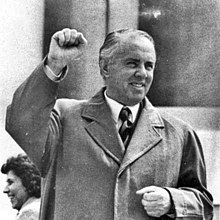
Before the Communists took power in 1944, it was estimated that of Albania's population of roughly 1,180,500 persons, about 70% belonged to Islamic sects while 30% belonged to Christian sects. Among the Muslims, at least 200,000 (or 17%) were Bektashis, while most of the rest were Sunnis, in addition to a collection of much smaller orders. Among the Christians, 212,500 (18%) were Orthodox while 142,000 (12%) were Catholic.[67]
The Agrarian Reform Law of August 1946 nationalized most property of religious institutions, including the estates of monasteries, orders, and dioceses. Many clergy and believers were tried, tortured, and executed. All foreign Roman Catholic priests, monks, and nuns were expelled in 1946.[68]
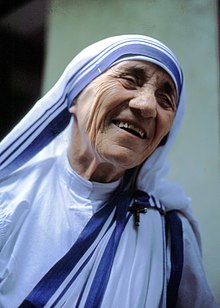
Religious communities or branches that had their headquarters outside the country, such as the Jesuit and Franciscan orders, were henceforth ordered to terminate their activities in Albania. Religious institutions were forbidden to have anything to do with the education of the young, because that had been made the exclusive province of the state. All religious communities were prohibited from owning real estate and from operating philanthropic and welfare institutions and hospitals. Although there were tactical variations in First Secretary of the Communist Party Enver Hoxha's approach to each of the major denominations, his overarching objective was the eventual destruction of all organized religion in Albania. Between 1945 and 1953, the number of priests was reduced drastically and the number of Roman Catholic churches was decreased from 253 to 100, and all Catholics were stigmatized as fascists.[68]
The campaign against religion peaked in the 1960s. Beginning in 1967 the Albanian authorities began a violent campaign to try to eliminate religious life in Albania. Despite complaints, even by Party of Labour of Albania members, all churches, mosques, tekkes, monasteries, and other religious institutions were either closed down or converted into warehouses, gymnasiums, or workshops by the end of 1967.[69] By May 1967, religious institutions had been forced to relinquish all 2,169 churches, mosques, cloisters, and shrines in Albania, many of which were converted into cultural centres for young people. As the literary monthly Nendori reported the event, the youth had thus "created the first atheist nation in the world."[68]
The clergy were publicly vilified and humiliated, their vestments taken and desecrated. More than 200 clerics of various faiths were imprisoned, others were forced to seek work in either industry or agriculture, and some were executed or starved to death. The monastery of the Franciscan order in Shkodër was set on fire, which resulted in the death of four elderly monks.[68]
A major center for anti-religious propaganda was the National Museum of Atheism (Albanian: Muzeu Ateist) in Shkodër, the city viewed by the government as the most religiously conservative.[70][71]
Article 37 of the Albanian Constitution of 1976 stipulated, "The State recognises no religion, and supports atheistic propaganda in order to implant a scientific materialistic world outlook in the people",[72] and the penal code of 1977 imposed prison sentences of three to ten years for "religious propaganda and the production, distribution, or storage of religious literature."[68] A new decree that in effect targeted Albanians with Islamic and religiously-tinged Christian names stipulated that citizens whose names did not conform to "the political, ideological, or moral standards of the state" were to change them. It was also decreed that towns and villages with religious names must be renamed.[68] Hoxha's brutal antireligious campaign succeeded in eradicating formal worship, but some Albanians continued to practise their faith clandestinely, risking severe punishment.[68] Individuals caught with Bibles, icons, or other religious objects faced long prison sentences.[68] Religious weddings were prohibited.[73] Parents were afraid to pass on their faith, for fear that their children would tell others. Officials tried to entrap practising Christians and Muslims during religious fasts, such as Lent and Ramadan, by distributing food at schools and workplaces during those fasting hours, and then publicly denouncing those who refused to eat during such times, and clergy who conducted secret services were incarcerated.[68]
The article was interpreted as violating The United Nations Charter (chapter 9, article 55) which declares that religious freedom is an inalienable human right. The first time that the question of religious oppression in Albania came before the United Nations' Commission on Human Rights at Geneva was as late as 7 March 1983. A delegation from Denmark got its protest over Albania's violation of religious liberty placed on the agenda of the thirty-ninth meeting of the commission, item 25, reading, "Implementation of the Declaration on the Elimination of all Forms of Intolerance and of Discrimination based on Religion or Belief." There was little consequence at first, but on 20 July 1984 a member of the Danish Parliament inserted an article in one of Denmark's major newspapers protesting the violation of religious freedom in Albania.[citation needed]
After the death of Enver Hoxha in 1985, his successor, Ramiz Alia, adopted a relatively tolerant stance toward religious practice, referring to it as "a personal and family matter." Émigré clergymen were permitted to reenter the country in 1988 and officiate at religious services. Mother Teresa, an ethnic Albanian, visited the country in 1989, where she was received in Tirana by the foreign minister and by Hoxha's widow and where she laid a wreath on Hoxha's grave. In December 1990, the ban on religious observance was officially lifted, in time to allow thousands of Christians to attend Christmas services.[74]
The atheistic campaign had significant results especially to the Greek minority, since religion which was now criminalized was traditionally an integral part of its cultural life and identity.[75]
Religions
Islam

Islam was first introduced to Albania in the 15th century after the Ottoman conquest of the area.[76][77] It is the largest religion in the country, nominally representing 50,67 % of the total population (Sunni Muslims, Bektashians and Non-denominational Muslims) according to the 2023 Census in Albania.[1] One of the major legacies of nearly five centuries of Ottoman rule was that the majority of Albanians had converted to Islam. Therefore, the nation emerged as a Muslim-majority country after Albania's independence in November 1912.
In the North, the spread of Islam was slower due to the resistance of the Roman Catholic Church and the region's mountainous terrain. In the center and south, however, Catholicism was not as strong and by the end of the 17th century the region had largely adopted the religion of the growing Albanian Muslim elite. The existence of an Albanian Muslim class of pashas and beys who played an increasingly important role in Ottoman political and economic life became an attractive career option for most Albanians. Widespread illiteracy and the absence of educated clergy also played roles in the spread of Islam, especially in northern Albanian-inhabited regions. During the 17th and 18th centuries Albanians converted to Islam in large numbers, often under sociopolitical duress experienced as repercussions for rebelling and for supporting the Catholic powers of Venice and Austria and Orthodox Russia in their wars against the Ottomans.[78][79]

In the 20th century, the power of Muslim, Catholic and Orthodox clergy was weakened during the years of monarchy and it was eradicated during the 1940s and 1950s, under the state policy of obliterating all organized religion from Albanian territories.
During the Ottoman invasion the Muslims of Albania were divided into two main communities: those associated with Sunni Islam and those associated with Bektashi Shiism, a mystical Dervish order that came to Albania through the Albanian Janissaries that served in the Ottoman army and whose members practised Albanian pagan rites under a nominal Islamic cover.[citation needed] After the Bektashis were banned in Turkey in 1925 by Atatürk, the order moved its headquarters to Tirana and the Albanian government subsequently recognized it as a body independent from Sunnism. Sunni Muslims were estimated to represent approximately 50% of the country's population before 1939, while Bektashi represented another 20%. Muslim populations have been particularly strong in eastern and northern Albania and among Albanians living in Kosovo and Macedonia.
Islam (Sunni)
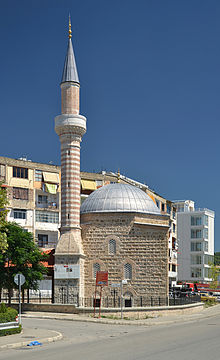
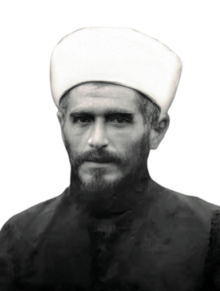
Sunni Muslims have historically lived in the cities of Albania, while Bektashis mainly live in remote areas, whereas Orthodox Christians mainly live in the south, and Roman Catholics mainly live in the north of the country. However, this division does not apply nowadays. In a study by Pew Research, 65% of Albanian Muslims did not specify a branch of Islam that they belonged to.[80] The Albanian census doesn't differentiate between Bektashis and Sunnis, but instead between Bektashis and "Muslims", but since Bektashis are in fact Muslim many were listed as Muslims. Bektashi-majority areas include Skrapari, Dishnica, Erseka and Bulqiza while Bektashis also have large, possibly majority concentrations in Kruja, Mallakastra, Tepelena, large pockets of the Gjirokastër and Delvina Districts (i.e. Gjirokastër itself, Lazarat, etc.), and Western and Northeastern parts of the Vlora district. There are also historically substantial Bektashi minorities around Elbasan, Berat, Leskovik, Perm, Saranda and Pogradec. In Kosovo and Macedonia there were pockets of Bektashis in Gjakova, Prizren and Tetova. In the Albanian census, a few of these areas, such as Skrapari and Dishnica, saw the Bektashi population mostly labeled "Bektashi" while in most other areas such as Kruja it was mostly labeled "Muslim". The classification of children of mixed marriages between Sunnis and Bektashis or the widespread phenomenon of both groups marrying Orthodox Albanians also have inconsistent classification and oftentimes the offspring of such unions associate with both of their parents' faiths and occasionally practice both.
In December 1992 Albania became a full member of the Organisation of the Islamic Conference (now the Organisation of Islamic Cooperation).
Bektashism
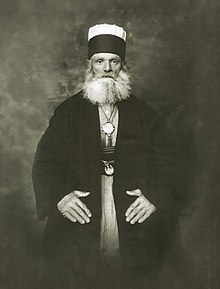
The Bektashi Order was widespread in the Ottoman Empire, with most leading Bektashi babas from southern Albania. The Bektashi order was banned throughout the Ottoman Empire by Sultan Mahmud II in 1826. After Mustafa Kemal Atatürk banned all Sufi orders in 1925, the Bektashi leadership moved to Albania and established their headquarters in the city of Tirana, where the community declared its separation from the Sunni. Under communist rule from 1945 - 1990, Bektashism was banned in Albania.
Many "tekkes" (lodges) operate today in Albania. Approximately 20% of Muslims identify themselves as having some connection to Bektashism.
Other Sufi congregations
This section possibly contains original research. (June 2018) |
Of the remaining mystical orders in Albania besides the Bektashi, there are those that associate with the mainline Sunni establishment, as well as those who feel themselves to be distant from both the Sunnis and Bektashis, and in terms of organization have oscillated between association with the Sunni establishment, with the Bektashis, and as their own independent organization. Today, these sects, the largest of them being the Halveti Order, and are organized and collectively referred to in Albania as the "Alevian Community" (Albanian: Komuniteti Alevjan) or the "Alevian Sects" (Albanian: Sektet Alevjan). There are other mystical orders who associate more with the Sunni establishment. There is no known direct relation of Alevjans to Turkish Alevis or Syrian Alawites except their ambiguous position between Sunnism and Shi'ism, also a characteristic of Bektashism.
The Halveti order first started to spread in Southern Albania in the 16th century and gained many followers later. They are considered to be less numerous than the Bektashis (and occasionally confused with them) but still significant. During periods of suppression of the Bektashis by the Ottoman authorities, Bektashi tekkes were often conferred upon the Halvetis, such as happened in Kanina, near Vlora[81] There are large concentrations of Halvetis in Devoll, Tropoja, Luma (around Kukes) and in mountainous valleys in the Kurvelesh region. Halvetis also live near Bektashis in Mallakastra, Tepelena, Gjirokastra, Delvina, Permet, Leskovik, Korca, and the city of Berat. The first Albanian Halveti tekke however was in Ioannina, now Greece. After the fall of communism, in 1998, it was reported that there were 42 Bektashi tekkes in Albania.[81] On the census Halvetis are not reported and are usually grouped under generalized "Muslims", although in public discourse they are frequently grouped with Bektashis. Halvetis are said to dislike both the dominance of mainline Sunnis in the generic "Muslim" community and the non-recognition of their sect's separate existence, but also the dominance of Bektashis in the Sufi scene.
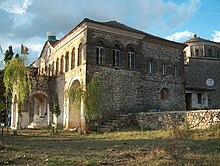
Besides the two most popular Dervish orders in Albania (Bektashis and Halvetis), there are three other significant Sufi orders: the Kadris (also known as "Kadris" or "Zinxhiris"), the Sadis and the Rufais.
The Rufais originated in Iraq as the "Rifa'is", from the teachings of the jurist Ahmad ibn 'Ali al-Rifa'i. Little is known about how they spread to the Balkans, but in the Balkans they became known as the "howling dervishes" because of ritual practices including piercing of lips and cheeks, eating of glass and burning of skin. Most of these practices have ceased but they still occur in Prizren, in Kosovo.[citation needed] In the late 19th century there was a flourishing Rufai community around Gjakova, in Kosovo, which helped spread the sect in various parts of Albania. During the early years of the 20th century some Rufai tekkes became Bektashi. At the same time, in the same period the order spread to Tropoja, Tirana, Petrela and parts of Southern Albania. In Albania all of their tekkes were closed due to the banning of religion under Communism, but in Yugoslavia the order continued to operate major tekkes in Gjakova, Mitrovica, Skopje, Peja, Rahovec and Prizren. After the fall of Communism, the order reconstituted itself in Albania and opened a tekke in Tirana in 1998.[82]
The Sa'dis originated in Damascus and in Albania have a close relationship with the Bektashis. Both were favored by Ali Pasha and they looked after and venerated each other's holy places and tombs. There was a Sa'di tekke in Gjakova in 1600, and two Sa'di tekkes in Tepelena two centuries later, as well as some historical presence in Tropoja, Gjirokastër, Elbasan and Peza. In 1980 in Kosovo, there are 10 operating Sa'di tekkes.[83]
The Kadris first originated as a distinct sect in Istanbul in the 17th century, then were spread to the Balkans as the "Zindjiris" by Ali Baba of Crete, originally spreading from within the Bektashi community. There are Kadri tekkes in Tirana, Berat and Peqin, but the main center of the Kadris is Peshkopia in Diber County. In 1945 they were finally recognized as a distinct religious community; since the fall of Communism, they have reconstituted themselves and now have an operating tekke in Peshkopia.[84]
Christianity
Roman Catholicism
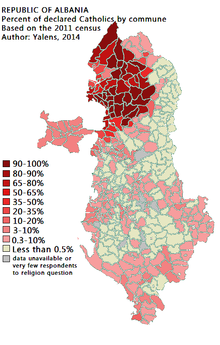
In the 2023 census, about 8.38% of Albania's population were declared as Roman Catholic Christianity.[1] Albania once numbered eighteen episcopal Sees, some of them having uninterrupted activity from the dawn of the Catholicism until today. The country has been a Roman Catholic bridgehead in the Balkans, with Catholic Albanians playing a role not unlike the Croats in the former Yugoslavia. In the Middle Ages, Albania was ruled by many Catholic rulers, including natives but notably the Angevins and it became a site of the spread of Catholicism in the Balkans at the expense of Orthodoxy as previously Orthodox Albanian nobles and their subjects converted as they grew increasingly loyal to the Western powers as a way to fend off threats coming from Orthodox political entities. Despite the ascendance of Catholicism at the time, Orthodox minorities remained. Before long, Durrës and Kruja became major centers of Balkan Catholicism, and in 1167 it was a significant event when Kruja became a Catholic bishopric, with the new bishop consecrated by the Pope himself.[85] Vlora and Butrint also saw Catholicization, and at the peak of Catholic power in the Balkans with Albania as a stronghold, Catholic structures began appearing as far afield as Skopje in 1326.[86] At the end of the 14th century, the previously Orthodox Autocephalous Archbishopric of Ohrid was dismantled in favor of the Catholic rite.[35]
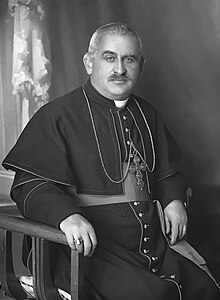
However, Ottoman rule ultimately vastly decreased the number of Catholics in Albania and elsewhere in the Balkans, with waves of conversions to Islam and to a lesser extent Orthodoxy occurring especially in the 17th century after a series of failed rebellions and punitive measures which involved drastic raises in the taxes of the Catholic population. The tribal population of Mirdita saw very few conversions because the ease they had defending their terrain meant the Ottomans interfered less in their affairs, and the Republic of Venice prevented Islamisation in Venetian Albania. Today, Catholic Albanians are mostly found in the areas of Malesia e Madhe, Kiri, Puka, Tropoja (where they are a minority), Mirdita, parts of northwestern Mat, Kurbin, Lezhe, Zadrima, Shkodër and Ulqin (where they live alongside very large numbers of Sunni Muslims), minorities in Kruja and some major cities, as well as scattered pockets throughout Gheg-inhabited areas. While there remained a small Albanian Catholic community in Vlore during Ottoman times, larger numbers of Catholics started were reported in the South after the fall of Communism, often in traditionally Orthodox areas.
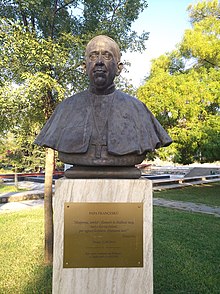
For four centuries, the Catholic Albanians defended their faith, aided by Franciscan missionaries, beginning in the middle of the 17th century, when persecution by Ottoman Turkish lords in Albania started to result in the conversion of many villages to the Islamic faith.
The College of Propaganda at Rome played a significant role in the religious and moral support of the Albanian Catholics. During the 17th and 18th centuries, the College contributed in educating young clerics appointed to service on Albanian missions, as well as to the financial support of the churches. Work was done by the Austrian Government at the time, which offered significant financial aid in its role as Protector of the Christian community under Ottoman rule.
Church legislation of the Albanians was reformed by Clement XI, who convoked a general ecclesiastical visitation, held in 1763 by the Archbishop of Antivari, by the end of which a national synod was held. The decrees formulated by the Synod were printed by the College of Propaganda in 1705, and renewed in 1803. In 1872, Pius IX convoked a second national synod at Shkodër, for the revival of the popular and ecclesiastical life. Owing to Austrian interest in Albania, the institution of the Catholic bishops of Albania was obtained through a civil decree released by the Vilajet of Berat.
Albania was divided ecclesiastically into several archiepiscopal provinces:
- Tivari Since 1878 part of the principality of Montenegro. Since 1886, it has been separate from Scutari, with which it had been united in 1867 on equal terms.
- Scutari, with the suffragan Sees of Alessio, Pulati, Sappa and (since 1888) the Abbatia millius of St. Alexander of Orosci.
- Durazzo
- Uskup
The last two archiepiscopal provinces did not have any suffragans, and depended directly on the Holy See. A seminary, founded in 1858 by Archbishop Topich of Scutari, was destroyed by the Ottomans, but was later re-established on Austrian territory and placed under imperial protection.
- Roman Catholicism in Albania
-
Church in Theth
Eastern Orthodoxy
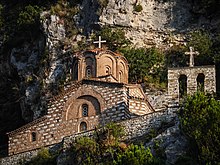
According to the 2023 Census, 7.22% of the Albanian population were declared themselves as Albanian Orthodox Church. Three ethnic groups, Albanians, Greeks, and Aromanians, account for the vast majority of Albania's Orthodox believers. Metropolitan Theofan Fan Noli established the Albanian Orthodox Mission under the American diocese.

Although Orthodox Christianity has existed in Albania since the 2nd century AD, and the Orthodox historically constituted 20% of the population [citation needed] of Albania, the first Orthodox liturgy in the Albanian language was celebrated not in Albania, but in Massachusetts. Subsequently, when the Orthodox Church was allowed no official existence in communist Albania, Albanian Orthodoxy survived in exile in Boston (1960–89). It is a curious history that closely entwines Albanian Orthodoxy with the Bay State. [citation needed]
Between 1890 and 1920, approximately 25,000 Albanians, the majority of them Orthodox Christians from southeastern Albania, emigrated to the United States, settling in and around Boston. Like many other Orthodox immigrants, they were predominantly young, illiterate, male peasants. Like so many other Balkan immigrants, a large number (almost 10,000) returned to their homeland after World War I. [citation needed]
Since the 2nd century AD, the liturgical services, schools and activities of the Orthodox Church in Albania had been conducted in Greek. When Albania came under Ottoman influence in the 15th century the Orthodox people of Albania were members of the Archbishopric of Ohrid which was officially recognized by the Ottoman Empire.[87]

Those Albanian Orthodox, who, in the fashion of 19th century Balkan nationalism, sought to see their church as an Albanian rather than Greek body, were frequently excommunicated by the Greek-speaking hierarchy. Considering that identity during the Ottoman centuries was defined primarily by religious affiliations, such questions in the post-Ottoman period loomed large in the burgeoning national and cultural identities. After the Ecumenical Patriarchate in Constantinople lost in 1870 jurisdictional control over the Bulgarians in the Ottoman Empire, the Patriarchate did not desire further schisms within its ranks. Indeed, so strong was the rivalry of Greeks with Orthodox Albanians who opted for separate cultural activities, that some of the latter category such as Papa Kristo Negovani, a priest educated in Greek schools, Sotir Ollani, Petro Nini Luarasi, Nuci Naco and others were murdered for their patriotic efforts.
Nationalist fervor ran high in Albanian immigrant communities in North America. When, in 1906, a Greek priest from an independent Greek parish in Hudson, Massachusetts, refused to bury an Albanian nationalist, an outraged Albanian community petitioned the missionary diocese to assist them in establishing a separate Albanian-language parish within the missionary diocese. [citation needed] Fan Noli, an ardent Albanian nationalist and former parish cantor, was subsequently ordained in February 1908 by a sympathetic Metropolitan Platon to serve this new Albanian parish. Noli went on to organize five additional Albanian parishes, mainly in Massachusetts, as an Albanian Orthodox Mission in America under the auspices of the American diocese. Noli later emigrated to Albania, served as the Albanian delegate to the League of Nations, was consecrated Bishop and Primate of the independent Orthodox Church in Albania in 1923, and even served briefly as Prime Minister of Albania (came in power with the so-called The Revolution of 1924) but was overthrown in a coup by Ahmet Zogu on the same year. After years in exile in Germany, Noli returned to the United States in 1932, studied at Harvard, translated Shakespeare into Albanian and Orthodox Scriptures and services into English, and led the Albanian Orthodox community in this country until his death in 1965. [citation needed]
Greek Catholicism
The Albanian Greek Catholic Church exists in southern Albania and is under an Apostolic Administration. It has less than 4,000 members.
Protestantism
In the early 19th century, in accordance with the Protestant practice of making the Scriptures available to all people in their common tongue, the British and Foreign Bible Society began to make plans for the translation, printing, and distribution of the New Testament in Albanian. Soon Alexander Thomson, a Scottish missionary, joined the Society and visited Albania in 1863. Kostandin Kristoforidhi also joined the Society to translate the Scriptures in both Geg and Tosk dialects. In the late 19th century the Society's workers traveled throughout Albania distributing Bibles, under the leadership of Gjerasim Qiriazi who converted, preached the Gospel in Korça, and became the head of the first "Evangelical Brotherhood".[88] Qiriazi sought official government recognition for the Albanian Evangelical Church in 1887, a pursuit which would not be fulfilled until 10 March 2011 by Law No. 10394.[89]
Judaism
The history of the Jews in Albania dates back at least 2,000 years dating back to 70 CE. Albanian Jews, predominantly Sephardi, have only constituted a very small percentage of the population in modern times.
In 1673 the charismatic Jewish prophet Sabbatai Zevi was exiled by the Turkish sultan to the Albanian port of Ulqin, now in Montenegro, dying there some years later.[90]
Over the course of World War II Albania saw its Jewish population increase. During the communist dictatorship of Enver Hoxha, the Socialist People's Republic of Albania banned all religions, including Judaism, in adherence to the doctrine of state atheism. In the post-Communist era, these policies were abandoned and freedom of religion was extended, although the number of practising Jews in Albania today remains small, with many Jews having made aliyah to Israel. Today Jews number around 150. In December 2010 Israeli Chief Rabbi Shlomo Amar installed Rabbi Yoel Kaplan as the country's first Chief Rabbi. Recognition of Judaism as an official religion and Rabbi Kaplan as Chief Rabbi were the result of Prime Minister Sali Berisha's efforts.[91]
Baháʼí Faith
The Baháʼí Faith in Albania was introduced in the 1930s by Refo Çapari, an Albanian politician. Over the recent years several Baháʼí education centres have also been founded.
Irreligion
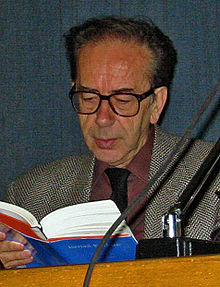
Irreligion is and has been historically present among Albanians. Nowadays, estimations of the size of the irreligious population vary widely. The self-declared atheist population has been given figures ranging from 2.5%[94] to 8%[95] to 9%[96] while other estimates of irreligiosity have reported figures of 39% declaring as "atheists"(9%) or "nonreligious"(30%),[96] 61% not saying religion was "important" to their lives,[96] and 72% "non-practising".[97]
Albanian national revivalists in the 19th century such as Faik Konica, Jani Vreto, and Zef Jubani were often anti-clerical in rhetoric (Konica said in 1897: "Every faith religion makes me puke", or Albanian: Më vjen për të vjellur nga çdo fe),[98] but the first advocate of atheism in modern Albania is thought to have been Ismet Toto, a publicist and revolutionary[99] whose 1934 anti-religious polemic, Grindje me klerin, was one of the first known works advocating against the practice of religion itself in the Albanian language.[100]
Under Socialist rule in 1967, leader Enver Hoxha persecuted and outlawed public religious practice and adopted state atheism.[101]
Some well-known Albanian contemporary atheists include Ismail Kadare, Dritëro Agolli,[102] Ben Blushi,[103] Fatos Lubonja,[104] Mustafa Nano,[105] Saimir Pirgu,[106] Diana Çuli,[107] Gilman Bakalli,[108] Fatos Tarifa,[109] Edmond Tupja,[110] Ylli Rakipi,[111] Elton Deda,[112] and Moikom Zeqo.[113]
Religious demography
Religious practice among Albanians (UNDP 2018) [114]

Green: Sunnis; Teal: Bektashis; Light Green: Other Shiite tarikats
Red: Catholics; Magenta: Orthodox; Orange: Other Christians
Light Blue: Jews and other
According to the 2023 census, there were 1,101,718 (45.86%) Muslims (mostly Sunni Muslims and Non-denominational Muslims) 201,530 (8.38%) Catholics, 173,645 (7.22%) Eastern Orthodox, 115,644 (4.81%) Bektashi Muslims, 9,658 (0.4%) Evangelicals, 3 670 (0.15%) of other religions, 332,155 (13.82%) believers without denomination, 85,311 (3.55%) Atheists and 378,782 (15.76%) did not provide an answer.[1]
Muslims are found throughout the country, while Orthodox followers are concentrated in the south and Catholics are concentrated in the north. However, this division is not strict, particularly in many urban centers, which have mixed populations. Members of the Greek minority, concentrated in the south, are almost exclusively Orthodox and belong to the Orthodox Church of Albania. In addition to the four traditional religious groups, there are substantial numbers of followers of Protestant denominations, Baháʼís, Jehovah's Witnesses, the Church of Jesus Christ of Latter-day Saints (Mormons), and other religious groups.
| Religion group | census 1923 | census 1927[115] | census 1942[116] | census 2011[117] | census 2023[118] | |||||
|---|---|---|---|---|---|---|---|---|---|---|
| Number | % | Number | % | Number | % | Number | % | Number | % | |
| Sunni Muslim | 558,000 | 68.5 | 563,729 | 67.6 | 599,912 | 54.2 | 1,587,608 | 56.7 | 1,101,718 | 45.86 |
| Bektashism | 163,811 | 14.7 | 58,628 | 2.09 | 115,644 | 4.81 | ||||
| Muslim | 558,000 | 68.5 | 563,729 | 67.6 | 763.723 | 68.9 | 1.646.236 | 58.79 | 1.217.362 | 50.67 |
| Roman Catholic Christian | 85,000 | 10.5 | 88,739 | 10.6 | 113,891 | 10.3 | 280,921 | 10.0 | 201,530 | 8.38 |
| Orthodox Christian | 171,000 | 20.5 | 181,051 | 21.7 | 229,080 | 20.7 | 188,992 | 6.75 | 173,645 | 7.22 |
| Evangelical | 5,616 | 0.2 | 9,658 | 0.4 | ||||||
| Christian | 256,000 | 31 | 269.790 | 32.3 | 342.971 | 31 | 475.529 | 16.77 | 384.833 | 16 |
| Atheists | 69,995 | 2.5 | 85,311 | 3.55 | ||||||
| Believers without denomination | 153,630 | 5.49 | 332,155 | 13.82 | ||||||
| Non-religious | 223,625 | 8.0 | 417,466 | 17.37 | ||||||
| Not stated / other | 99 | 0.01 | 156 | 0.01 | 454,046 | 16.2 | 382,452 | 15.91 | ||
| TOTAL | 814,000 | 100 | 833,613 | 100 | 1,106,850 | 100 | 2,800,138 | 100 | 2,402,113 | 100 |
In a census performed before World War II, a rough distribution of the population was 70% Muslim, 20% Eastern Orthodox, and 10% Roman Catholic. 65% of Albanian Muslims did not associate with particular sect of Islam in a Pew survey.[80] In 1967, religious practices were officially banned in Albania, making the country the first and only constitutionally atheist state to ever exist.[119] After the fall of state communism, in 1991 religious activities resumed.[120] Among people who follow any of the four major religions in Albania, there is a mixture of various religious traditions and pagan traditions coming from the time before Christianity.[121]
Interfaith marriages between Muslims and Christians are held to be "common" and "unremarkable" in Albania with little social repercussion, although there is little statistical data on their prevalence. During the communist period, it is known that during the period of 1950–1968, the rates of mixed marriages ranged from 1.6% in Shkodër, 4.3% in Gjirokastër to 15.5% among the textile workers in Tiranë.[122] In the district of Shkodër they reached 5% in the year 1980.[123]
However, even among those who declared themselves to be adherents of a religion, the majority of the population in Albania has a more secular interpretation of religion than that which would be found in other countries. In August 2012, a Pew Research study found that only 15% of the Muslim population for example, considers religion to be a very important factor in their lives, which was the lowest percentage in the world amongst countries with significant Muslim populations.[124] Another survey conducted by Gallup Global Reports 2010 shows that religion plays a role to 39% of Albanians, and lists Albania as the thirteenth least religious country in the world.[125] Also in Albania the majority of the males are not circumcised (as demanded by Islamic custom).[126]
A 2015 study on the Albanian youth aged 16–27 found that total of 80 percent of young people in Albania are not religion practitioners and practise their religion only during the main religious holidays and festivities. Specifically 23 percent of the respondents never practised their religion, while 61 percent practised it only in religious holidays. From the rest, 11 percent practised it 1–2 times a week, while 5 percent practised it every day.[127]
A 2022 poll commissioned by Euronews Albania showed that 50.7% in Albania never visit go to religious places of worship, 27.6% visit them only for religious festivities and 19.2% visit them at least once a month.[128]
Beliefs and rituals data
According to a WIN/Gallup International study in 2016 about the beliefs of the Albanians:
- 80% believed there's God
- 40% believed in life after death
- 57% believed that people have a soul
- 40% believed in hell
- 42% believed in heaven[129]
In the World Values Survey wave 6 (2017-2022) Albania had the lowest belief in life after death in Europe at 22.7%.
| Believe in life after death (World Values Survey, 2017)[130] | % | |
|---|---|---|
| Yes | 22.7 | |
| No | 57.9 | |
| Don't know | 19.0 | |
| No answer | 0.4 | |
A 2024 survey by the Institute for Democracy and Mediation asked about ritual practice in Albania giving the below results:
| Practice of religious rituals in Albania (2024 IDM poll)[131] | % | |
|---|---|---|
| "YES, I regularly practise all rituals of my religion" | 10.5 | |
| "Mainly YES, I practise the main religious rituals": | 30.3 | |
| "NO, I am a believer, but I do not practise religious rituals at all" | 44.2 | |
| "NO, I am an atheist" | 5.6 | |
| "Refused to say" | 8.9 | |
| "Other" | 0.5 | |
Places of worship
This article needs to be updated. (July 2017) |
According to 2008 statistics from the religious communities in Albania, there are 1,119 churches and 638 mosques in the country. The Roman Catholic mission declared 694 Catholic churches. The Christian Orthodox community, 425 Orthodox churches. The Muslim community, 568 mosques, and 70 Bektashi tekkes.[132][133][134][135]
Freedom of religion

The Constitution extends freedom of religion to all citizens and the government generally respects this right in practice.[136] The Albanian Constitution declares no official religion and provides for equality of all religions; however, the predominant religious communities (Bektashi, Sunni Muslim, Orthodox and Roman Catholic) enjoy a greater degree of official recognition (e.g. national holidays) and social status based on their historical presence in the country. All registered religious groups have the right to hold bank accounts and to own property and buildings. Religious freedoms have in large part been secured by the generally amicable relationship among religions. The Ministry of Education has the right to approve the nonreligious curricula of religious schools to ensure their compliance with national education standards. There are also 113 educational institutions managed by religious communities.[136]
Government policy and practice contributed to the generally free exercise of religion. The government is secular and the Ministry of Education asserts that public schools in the country are secular and that the law prohibits ideological and religious indoctrination. Religious history and comparative religion may be taught in the context of humanities instruction in public schools, while private schools are allowed to teach religious instruction.[136]
See also
Religions
- Christianity in Albania
- Roman Catholicism in Albania
- Orthodoxy in Albania
- Islam in Albania
- Protestantism in Albania
- Irreligion in Albania
- Judaism in Albania
References
- ^ a b c d e "Population and Housing Census 2023" (PDF). Instituti i Statistikës (INSTAT).
- ^ "1998 Constitution of the Republic of Albania" (PDF). Organization for Security and Co-operation in Europe (OSCE). Archived from the original (PDF) on 30 July 2020. Retrieved 30 July 2020.
- ^ "Albania". International Religious Freedom Report 2009. Bureau of Democracy, Human Rights, and Labor, United States Department of State. 26 October 2009. Retrieved 7 November 2009.
- ^ Bogdani, Mirela; Loughlin, John (2007). Albania and the European Union: The Tumultuous Journey Towards Integration and Accession. I.B.Tauris. p. 34. ISBN 978-1-84511-308-7. Retrieved 16 April 2017.
- ^ https://www.instat.gov.al/media/11948/census-2023-en.pdf [bare URL PDF]
- ^ "Constitution of Albania" (PDF). Archived from the original (PDF) on 7 March 2010. Retrieved 29 December 2012.
- ^ "Revelations from the Russian Archives: ANTI-RELIGIOUS CAMPAIGNS". Library of Congress. US Government. Retrieved 2 May 2016.
- ^ Kowalewski, David (October 1980). "Protest for Religious Rights in the USSR: Characteristics and Consequences". Russian Review. 39 (4): 426–441. doi:10.2307/128810. JSTOR 128810.
- ^ Ramet, Sabrina Petra., ed. (1993). Religious Policy in the Soviet Union. Cambridge University Press. pp. 4. ISBN 9780521416436.
- ^ Anderson, John (1994). Religion, State and Politics in the Soviet Union and Successor States. Cambridge, England: Cambridge University Press. pp. 3. ISBN 0-521-46784-5.
- ^ Schnabel, Sckhard. Paul the Missionary: Realities, Strategies, and Methods. Downers Grove, IL: InterVarsity Press, 2008. p. 113.
- ^ Elsie, Robert (2001). A Dictionary of Albanian Religion, Mythology, and Folk Culture. NYU Press. ISBN 978-0-8147-2214-5.
- ^ Lloshi p.92
- ^ Sumruld, William A. (1994). Augustine and the Arians: The Bishop of Hippo's Encounters with Ulfilan Arianism. Associated University Presse. ISBN 978-0-945636-46-5.
- ^ Leften Stavros Stavrianos (January 2000). The Balkans Since 1453. C. Hurst & Co. Publishers. p. 498. ISBN 978-1-85065-551-0. Retrieved 17 July 2013.
Religious differences also existed before the coming of the Turks. Originally, all Albanians had belonged to the Eastern Orthodox Church... Then the Ghegs in the North adopted in order to better resist the pressure of Orthodox Serbs.
- ^ Bourchier, James David (1911). . In Chisholm, Hugh (ed.). Encyclopædia Britannica. Vol. 01 (11th ed.). Cambridge University Press. pp. 481–487, see page 485.
Religions.—The great majority of the Albanians......The Roman Catholic Ghegs appear to have abandoned the Eastern for the Western Church in the middle of the 13th century
- ^ Ramet, Sabrina P. (1989). Religion and Nationalism in Soviet and East European Politics. Duke University Press. p. 381. ISBN 0-8223-0891-6.
Prior to the Turkish conquest, the ghegs (the chief tribal group in northern Albania) had found in Roman Catholicism a means of resisting the Slavs, and though Albanian Orthodoxy remained important among the tosks (the chief tribal group in southern Albania),...
- ^ Anamali & Prifti 2002, p. 197.
- ^ Osswald, Brendan. "The Ethnic Composition of Medieval Epirus". Page 133
- ^ Zhelyazkova, Antonina. Albanian Identities. Page 3
- ^ Lala (2008), p. 157
- ^ Lala (2008), p. 54-55
- ^ Acta Albaniae I, no 74
- ^ Lala(2008). Regnum Albaniae. Page 153: "the town of Prizren, which was also an Orthodox bishopric with some catholic parochial churches until then... received a real catholic bishop (1372) as a result of the good connections between Balsha and Rome"
- ^ a b Lala (2008), p. 146
- ^ a b Lala (2008), p. 91-95
- ^ Lala (2008), p. 147-148
- ^ Lala (2008) p. 155
- ^ a b Lala, Etleva. Regnum Albaniae. Page 153
- ^ Lala, Etleva. Regnum Albaniae. Page 74
- ^ Lala (2008), p. 149-153
- ^ Elsie, Robert. Texts and Documents of Albanian History. 1332 Anonymous: Initiative for Making the Passage. "...it is inhabited by two peoples, i.e. the Albanians and the Latins who, in their beliefs, their rites and their obedience, both abide by the Roman Catholic Church... The Latins have six towns with bishops: firstly Antibarum (Bar), the seat of the archbishop, then Chatarensis (Kotor), Dulcedinensis (Ulcinj), Suacinensis (Shas) (2), Scutarensis (Shkodra) and Drivascensis (Drisht) (3), which are inhabited by the Latins alone. Outside the town walls, the Albanians make up the population throughout the diocese. There are four Albanian towns: Polatum Maius (Greater Pult) (4), Polatum Minus (Lesser Pult), Sabatensis (Sapa) (5) and Albanensis (Albanopolis) (6) which, together with the towns of the Latins, are all legally subject to the Archbishop of Bar and his church as their metropolitan. The Albanians indeed have a language quite different from Latin. However they use Latin letters in all their books (7). The sway of the Latins is thus confined to the limits of their towns. Outside the towns, they do possess vineyards and fields, but there are no fortifications or villages actually inhabited by the Latins. The Albanians for their part, the larger of the two peoples, could assemble over fifteen thousand horsemen for warfare according to the custom and manner of the country, who would be courageous and industrious warriors. Since the said Latins and Albanians suffer under the unbearable yoke and extremely dire bondage of their odious Slav leaders whom they detest – the people being tormented, the clergy humiliated and oppressed, the bishops and abbots often kept in chains, the nobles disinherited and held hostage, episcopal and other churches disbanded and deprived of their rights, and the monasteries in decay and ruin – they would all to a man believe that they were consecrating their hands in the blood of the aforementioned Slavs if a French prince were to appear... With the help of the aforementioned Albanians and Latins, one thousand French knights and five or six thousand foot soldiers could without a doubt easily conquer the whole length and breadth of this kingdom."
- ^ Lala, Etleva. Regnum Albaniae. Page 118.
- ^ Lala (2008), p. 118-119: "...called the Catholic rite the 'Latin heresy', the good relations between the local Catholic population and the Serbs came to an end... In this situation the good relations between the papacy and Catholic Albanians became very tight"
- ^ a b Lala, Etleva. Regnum Albaniae. Page 153: "at the end of the fourteenth century, there was a dismantling of the autocephalous archbishopric of Ochrid in favor of the Catholic rite"
- ^ Anton Minkov. Conversion to Islam in the Balkans. pp. 41–42.
- ^ Vryonis, Spyros. Religious Changes and Patterns in the Balkans, 14th–16th centuries
- ^ a b Zhelyazkova, Antonina. ‘’Albanian Identities’’. Sofia, 2000: International Center for Minority Studies and Intercultural Relations. Page 15-16
- ^ a b Florian Bieber (19 August 2010). "Muslim identity in the Balkans before the establishment of nation states". Nationalities Papers: The Journal of Nationalism and Ethnicity. pp. 15–19.
- ^ Zhelyazkova, Antonina, ‘’Albanian identities’’, page 15.
- ^ Zhelyazkova, Antonina. ‘’Albanian Identities’’. Page 19.
- ^ Winnifrith, Tom (2002). Badlands, Borderlands A History of Northern Epirus-Southern Albania. Gerald Duckworth, Limited. ISBN 978-0-7156-3201-7.
- ^ Ruches, Pyrrhus J. (1965). Albania's Captives. Argonaut.
- ^ Antonia Young, Ethnographic Report Archived 2006-10-10 at the Wayback Machine (Shala Valley Project, December 2005)
- ^ Marmullaku, ‘’Albania and the Albanians’’. London: C. Hurst & co., 1975. Page 16.
- ^ Jelavich, Barbara. ‘’History of the Balkans.’’ Cambridge: Cambridge University Press, 1983. Pages 80–81.
- ^ a b c d Zhelyazkova, Antonina. ‘’Albanian Identities’’. Page 22
- ^ a b Elsie, Robert. ‘’The Historical Dictionary of Albania, Second Edition’’. Lanham, 2010: The Scarecrow Press, Inc. Page 74-75.
- ^ Zhelyazkova, Antonina. ‘’Albanian Identities’’. Page 21
- ^ Elsie, Robert. ‘’Historical Dictionary of Albania’’. Pages 201–202.
- ^ http://en.radiovaticana.va/news/2014/09/21/fr_lombardi_papal_journey_a_blessing_for_all_albanians/1107019, ..."a silver portrait of Pope Clement XI – who belonged to the Albani family, so was traditionally of Albanian origin."
- ^ Malcolm, Noel (1998). ‘’Kosovo: a short history’’. Page 162.
- ^ Elsie, Roberts. Historical Dictionary of Albania. Page 7
- ^ a b Isufi, Hajredin (2004). "Aspects of Islamization in Çamëri". ‘’Historical Studies’’ (in Albanian). Tirana, Albania: Institute of History. ‘’’3’’’ (4) : 17–32.
- ^ a b c d Giakoumis, Kosta (2010). "The Orthodox Church in Albania Under the Ottoman Rule, 15th- 19th Century". In Rathberger A. [ed.] (2010), ‘’Religion und Kultur im albanischschprachen sudosteuropen’’. Page 8-11
- ^ Schmitt, Oliver Jens. ‘’Religion und Kultur im albanischsprachigen Südosteuropen. Page 86: "In 1739, twenty-five villages in Thesprotia were forced to convert to Islam en masse
- ^ Arno E (1935). "Venezia e l’Albania", ‘’Rassegna Italiana’’, version 14. Page 12.
- ^ Çarçani, Leonard (2007). ‘’Besimet Fetare në Prefekturen e Elbasanit’’. Page 11.
- ^ Skendi, Stavro (1956). Albania. Praeger publications in Russian history and world communism. Vol. 46. Frederick A. Praeger. p. 287.
- ^ Hutchinson, John; Smith, Anthony D. Nationalism: Critical Concepts in Political Science.
- ^ "Albania". Time. 14 April 1923.
- ^ "Swiss Laws, Greek Patriarch". Time. 15 April 1929.
- ^ Jacques, Edwin. The Albanians, an ethnic history from prehistoric times to the present.
- ^ a b Fischer 1999, pp. 5, 21–25.
- ^ a b c d e f g Fischer 1999, pp. 52–58.
- ^ "Shqiptarja.com – Patriotë apo tradhëtarë?!". Shqiptarja.com. Retrieved 20 October 2017.
- ^ Keefe, Eugene K. (January 1971). Area Handbook for Albania. p. 95.
- ^ a b c d e f g h i "Albania – Hoxha's Antireligious Campaign (Country Studies Series by Federal Research Division of the Library of Congress)". Retrieved 14 May 2015.
- ^ "Albania – The Cultural and Ideological Revolution". Retrieved 14 May 2015.
- ^ Vickers, Miranda; Pettifer, James (2000), Albania: From Anarchy to a Balkan Identity, NYU Press, pp. 99, 109, ISBN 0-8147-8805-X
- ^ Mustafa, Mentor (2008). "What Remained of Religion in an "Atheist" State and the Return of Religion in Post-Communist Albania". In Repič, Jaka; Bartulović, Alenka; Sajovec Altshul, Katarina (eds.). MESS and RAMSES II. Vol. 7, Mediterranean Ethnological Summer School. Univerza v Ljubljani, Filozofska fakulteta. p. 67. ISBN 978-961-237-279-8. Retrieved 10 July 2015.
- ^ "Education, science, culture". The constitution of the People's Socialist Republic of Albania. Bjoern Anderse. March 2005.
- ^ "Albania – Social Structure under Communist Rule". Retrieved 14 May 2015.
- ^ "Albania – The Revival of Religion". Retrieved 14 May 2015.
- ^ Nußberger Angelika; Wolfgang Stoppel (2001), Minderheitenschutz im östlichen Europa (Albanien) (PDF) (in German), p. 19-20: "Vor allem für die griechische Minderheit hatte das Verbot verheerende Folgen, da für sie Kirche und Religion traditionell Teil ihres kulturellen Lebens wie ihrer nationalen Identität beinhalten, was nunmehr kriminalisiert und in den Untergrund gedrängt wurde.: Universität Köln
{{citation}}: CS1 maint: location (link) - ^ Crampton 2014, p. 38.
- ^ Boehm 1994, p. 307. "The Ottoman Turks first introduced Islam into Albania when they conquered the country in the late 15th century."
- ^ Ramet, Sabrina (1998). Nihil obstat: religion, politics, and social change in East-Central Europe and Russia. Duke University Press. ISBN 9780822320708. pp. 203–204, 209–210.
- ^ Keefe, Eugene K. (January 1971). Area Handbook for Albania. pp. 95–96.
- ^ a b "Chapter 1: Religious Affiliation". The World's Muslims: Unity and Diversity. Pew Research Center's Religion & Public Life Project. 9 August 2012
- ^ a b Elsie, Robert. Historical Dictionary of Albania. pp. 39, 181–183.
- ^ Elsie, Robert. Historical Dictionary of Albania. Pages 386–387.
- ^ Elsie, Robert. Historical Dictionary of Albania. Pages 393–4.
- ^ Elsie. Historical Dictionary of Albania. Page 222-223.
- ^ Lala, Etleva (2008). "Regnum Albania, the Papal Curia, and the Western Visions of a Borderline Nobility". Budapest, Hungary: Central European University, 2008. page 157.
- ^ Lala, Etleva (2008). Regnum Albaniae. Page 74
- ^ Egro, Dritan (2010), "Islam in the Albanian lands (XVth to the XVIIth Century)", in Schmitt, Oliver Jens (ed.), Religion und Kultur im albanischsprachigen Südosteuropa, vol. 4, Frankfurt am Main: Peter Lang, p. 25, ISBN 978-3-631-60295-9,
The Orthodox Albanians ...religiously ... were members of the church that was officially recognized by the Ottoman state.... The Archbishopric of Ohrid.
- ^ "Development of the Protestant church amongst Albanians". Kosova Protestant Evangelical Church. Archived from the original on 2 March 2014.
- ^ FLETORJA ZYRTARE E REPUBLIKËS SË SHQIPËRISË. Nr. 34, 07 prill 2011.
- ^ A dictionary of Albanian religion, mythology and folk culture by Robert Elsie Edition illustrated Publisher C. Hurst & Co. Publishers, 2001 ISBN 1-85065-570-7, ISBN 978-1-85065-570-1 page 141
- ^ Ynetnews: 1st chief rabbi inaugurated in Albania, 17 December 2010
- ^ "Born near the Greek border in Gjirokaster in 1936, of two Muslim parents, Kadare claims to be an atheist. However, much of his language, especially when he talks of forgiving the old Stalinist order rather than seeking revenge, is Christian. The paradox, then, is that Kadare is a humanist who claims that the greatest riches of Albanian culture derive from its Christian tradition." John Murray, 'The Orphan's Voice', The Independent (London), 25 January 1998, Page 25.
- ^ Muslim Identity and the Balkan State, Hugh Poulton, Suha Taji-Farouki, 1997, ISBN 1-85065-276-7, google print, p. 133.
- ^ "2011 Census-AL" [2011 Census-AL] (PDF) (in Albanian). INSTAT. 2011. Archived from the original (PDF) on 26 March 2017. Retrieved 16 April 2017.
- ^ Zuckerman, Phil (2006). "Atheism: Contemporary Numbers and Patterns". In Martin, Michael (ed.). The Cambridge Companion to Atheism. Cambridge University Press. pp. 47–66. ISBN 9780521842709.
- ^ a b c "Research: 95 percent of Turkey believes in god, 74 percent is 'religious'(In Turkish)". Diken.com.tr. 6 May 2017.
- ^ "Instantanés d'Albaníe, un autre regard sur les Balkans" (PDF). 2005. Archived from the original (PDF) on 14 June 2007. Retrieved 20 July 2017.
Etudiants en Tourisme et Actions Patrimoniales. (plus de 72 % irréligieux ou non pratiquants. 28 % se répartissent en 21 % musulmans, 6% orthodoxes, 3 % catholiques. )
- ^ "Myslimanët shqiptarë, "në anën e gabuar të historisë"". Gazeta Shqip. 11 September 2014. Retrieved 27 July 2017.
Është spekuluar shumë lidhur me identitetin fetar të Konicës. Fakti që ai ka lindur në një familje myslimane nuk ha fare diskutim, e prandaj të vjen çudi se si miku i tij, poeti francez, Guillame Apollinaire, ka shkruar për të se "[ka lindur] në një familje që ka ruajtur besimin katolik"; nuk merret vesh se nga e ka nxjerrë këtë xhevahir. Ndonjë tjetër ka mbrojtur tezën se ai është konvertuar në vitin 1895 në katolik, madje është pagëzuar, ka marrë emrin Domenic, mirëpo Konica vetë, edhe pas këtij momenti, jo vetëm që nuk ka folur kurrë për konvertimin e vet në fenë katolike, por ka vijuar të shkruajë me gjuhën e një ateisti nervoz. "Më vjen për të vjellur nga çdo fe", thosh ai në një shkrim të vitit 1897, d.m.th. dy vjet pas konvertimit putativ në fenë katolike.
- ^ Nasho Jorgaqi (22 December 2013). "Ismet Toto, intelektuali kryengritës". Shqiptarja.Com. Retrieved 20 August 2017.
- ^ "Diktatura dhe besimet fetare | Drita Islame". Archived from the original on 2017-07-28. Retrieved 2017-07-27.
- ^ Fatos., Tarifa (2007). To Albania, with love. Lanham: Hamilton Books. ISBN 978-0-7618-3590-5. OCLC 84906031.
- ^ "Sadije Agolli: Dritëroi e kishte parashikuar vdekjen, pse vendosi të ikë" (in Albanian). Retrieved 2018-10-16.
- ^ "OPINION – A NA KERCENON TERRORIZMI ISLAMIK ? – TV KLAN". 8 January 2015. Retrieved 30 July 2017.
- ^ Opinion.al. "TOLERANCA FETARE, REALITET APO MIT?". Opinion.al (in Albanian). Retrieved 2017-07-30.
- ^ "Myslimanët nuk janë shumicë; por edhe sikur të ishin…. | Gazeta Mapo". www.mapo.al. Archived from the original on 2017-09-08. Retrieved 2017-09-08.
- ^ "Mediat italiane: Saimir Pirgu si në përrallë, nga Shqipëria në operat e mëdha - Shqiptarja.com". shqiptarja.com (in Albanian). Retrieved 2019-02-15.
- ^ "Debati për veshjen islame, Diana Çuli: Fetë monoteiste diskriminojnë gratë - Tirana Post". Tirana Post (in Albanian). 2017-07-11. Retrieved 2017-07-30.
- ^ "Gilman Bakalli: Kam marrë kërcënime nga myslimanët. Kemi frikë të kritikojmë". Gazeta Dita. Retrieved 2018-11-09.
- ^ "Replikë absurdit të Fatos Tarifës: "A na duhet më Feja"?!". Agjencia e Lajmeve SOT NEWS. 2015-04-14. Retrieved 2018-06-24.
- ^ "Edmond Tupja: Na duhet një Robin Hood, unë kam marrë damkën e turpit e lirisë". Balkanweb.com (in Albanian). Retrieved 2018-06-24.
- ^ "Flet nga qelia imami Bujar Hysa: Lidhjet e mia me ISIS dhe si më dënuan amerikanët" (in Albanian). Retrieved 2018-06-24.
- ^ "Elton Deda: Nuk besoj në zot, pasi nuk ka zot". Retrieved 2017-07-30.
- ^ "Frederik Rreshpja: MoikomZeqo midis artit dhe shkencës - Shqiptarja.com". shqiptarja.com (in Albanian). Retrieved 2019-02-25.
- ^ "Religious Tolerance in Albania" (PDF). UNDP. 25 April 2018.
- ^ "Religious composition of Albania 1927". pop-stat.mashke.org. Archived from the original on 23 June 2023. Retrieved 2023-06-23.
- ^ "Historic population statistics of Albania". pop-stat.mashke.org. Archived from the original on 16 October 2021. Retrieved 2023-06-23.
- ^ "1.1.14 Resident population by religious affiliation by Religious affiliation, Type and Year". PxWeb. Archived from the original on 13 April 2023. Retrieved 2023-06-23.
- ^ https://shqiptarja.com/uploads/ckeditor/667eb96647c4bcens-2023.pdf [bare URL PDF]
- ^ "The Albanian Constitution of 1976". Bjoern Andersen, Sociologist. Retrieved 9 April 2013. Article 37: "The state recognizes no religion whatever and supports atheist propaganda for the purpose of inculcating the scientific materialist world outlook in people."
- ^ "Europe :: Albania — The World Factbook - Central Intelligence Agency". www.cia.gov. 11 January 2022.
- ^ "Albanian faiths blend together after hard times". The Daily Tribune. Agence France-Presse. 14 April 2011. Archived from the original on 18 May 2015. Retrieved 5 January 2012.
- ^ ""Albania – Researched and compiled by the Refugee Documentation Centre of Ireland on 13 November 2012 "" (PDF).
- ^ https://hal.archives-ouvertes.fr/halshs-00189819/document [bare URL PDF]
- ^ "Infographic: The World's Muslims: Unity and Diversity". Pew Research Center's Religion & Public Life Project. 9 August 2012. Retrieved 14 May 2015.
- ^ Gallup, Inc. "World". Archived from the original on 27 September 2012. Retrieved 14 May 2015.
- ^ https://dhsprogram.com/pubs/pdf/FR230/FR230.pdf WHO page 236
- ^ "Albanian Youth 2015" (PDF). "Friedrich Ebert" Foundation: 35.
- ^ nc, fra (2022-05-26). "Sa shqiptarë e praktikojnë besimin e tyre fetar?". Euronews Albania. Retrieved 2024-07-04.
- ^ "Archived copy" (PDF). Archived from the original (PDF) on 14 November 2017. Retrieved 27 February 2018.
{{cite web}}: CS1 maint: archived copy as title (link) - ^ "WVS Database". www.worldvaluessurvey.org. Retrieved 2024-07-06.
- ^ IDM (2024-04-02). "The 2024 Assessment of Violent Extremism in Albania". Welcome to IDM. Retrieved 2024-07-06.
- ^ "Tiranë: Në Shqipëri ka 1119 kisha dhe 638 xhami e teqe – August 18, 2008". Archived from the original on 2017-08-08. Retrieved 2017-08-08.
- ^ "Kultet: Gjysma e xhamive, pa leje". Korrieri (in Albanian). 20 May 2005. Archived from the original on 23 May 2005.
- ^ "Raport ekskluziv / Në Shqipëri ka 638 xhami dhe 1119 kisha" [Exclusive Report / Albania has 638 mosques and 1119 churches]. Tirana Observer (in Albanian). 16 August 2008. Archived from the original on 17 September 2008.
- ^ "Shqipëri: Gjysma e xhamive, pa leje". Ateistët. Archived from the original on 2017-08-08. Retrieved 14 May 2015.
- ^ a b c "Albania". United States Department of State. Retrieved 2023-12-05.
Sources
- Anamali, Skënder; Prifti, Kristaq (2002). Historia e popullit shqiptar në katër vëllime. Botimet Toena. ISBN 978-99927-1-622-9. (in Albanian)
- Boehm, Eric H. (1994). Historical Abstracts: Modern history abstracts, 1450-1914. Clio Press.
- Crampton, Richard J. (2014). The Balkans since the Second World War. Hoboken: Routledge. ISBN 9781317891178.
- Fischer, Bernd J. (1999). Albania at War, 1939–1945. Purdue University Press. ISBN 978-155753141-4.
- Lloshi, Xhevat (2008). Rreth Alfabetit te Shqipes. Logos. ISBN 9789989582684.
- Wilkes, J.J. (1995). The Illyrians. Wiley-Blackwell. ISBN 0-631-19807-5.
External links
- Albanian Atheists
- Albanian Protestants
- Kisha Katolike Shkodër, Shkodra Catholic Church
- Famullia Gjakovë, Gjakova Catholic Church
- Catholic Church in Albania
- Albanian Orthodox Forum
- Orthodox Autocephalous Church of Albania
- Arbëresh Christian Eparchy
- The Bektashi Community
- Myftinia Shkodër, Mufti of Shkodra City
- Newspaper "Drita Islame"
- Magazine "Familja"




